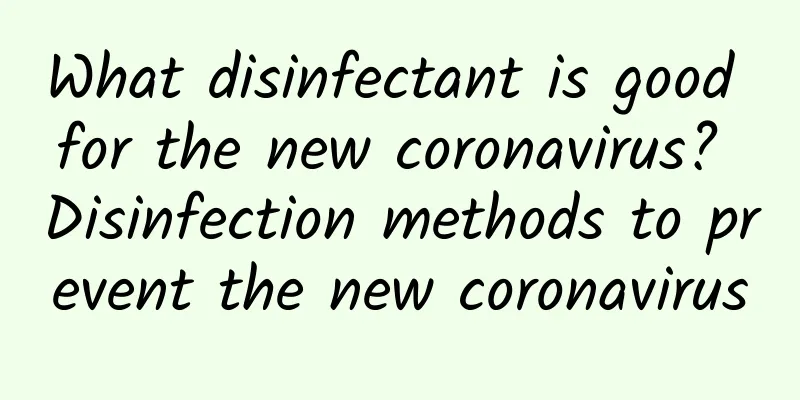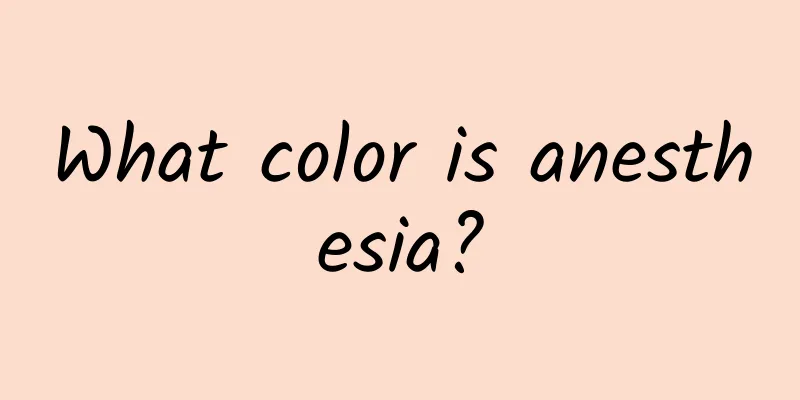What disinfectant is good for the new coronavirus? Disinfection methods to prevent the new coronavirus

|
We all know that the new coronavirus is a highly contagious virus. Many people have been infected with the new coronavirus, and the number of infections is increasing. In order to reduce infection, everyone must pay attention to protection and disinfection. So what disinfectant is good for the new coronavirus? Let's take a closer look! What disinfectant is best for the new coronavirus?1. Disinfect your hands with alcoholThe new coronavirus is actually afraid of high temperatures and alcohol. Therefore, it is recommended that you do the following two things after returning home from outside. A. Wash your hands! You must use soapy water and wash your hands for a long enough time, otherwise it is very likely that you will not wash them thoroughly. B. After washing your hands, disinfect them with alcohol! According to previous experience with coronavirus, 75% alcohol can effectively kill coronavirus! 2. Use 84 disinfectant to disinfect the environment where you live.Do you remember that when SARS was prevalent, many families used vinegar for fumigation for a while? In fact, regarding the new coronavirus, we don’t know whether vinegar is effective. However, according to past experience, chlorine-containing disinfectants such as 84 disinfectant can still kill viruses. In addition, for example: New Ear Cleanser, hydrogen peroxide (the "medicine smell" you can smell in the hospital is actually these two disinfectants). Experts believe that for ordinary families, 84 disinfectant is simple, easy to obtain, and economical, so you may want to consider it. 3. Hydrogen peroxide solutionIt can usually be used to disinfect and sterilize your skin, for example, it is used in medicine to treat purulent external auditory canal, and it can also kill viruses. Let's talk about the pros and cons: This product is more suitable for anaerobic infections. Although it can kill viruses, the effect is very general, and it has a certain corrosive effect on metals, so it is not recommended for spraying. 4. Sanisol (Benzalkonium Bromide)It is commonly used in public places, and this method is usually used for hospital environment disinfection. Advantages and disadvantages: Sanisol has no corrosive effect on metals and will not cause certain pollution to your clothes. It can quickly combine with proteins and inactivate them, but it has poor effect on cotton, fiber and other organic products. In addition, Sanisol is highly irritating and corrosive to the skin and eyes. The degree of damage to our body is proportional to the length of contact time. If the eyes are not cleaned in time after contact, it may cause damage to the cornea or even blindness. There will be a certain burning sensation or even blisters after skin contact. Disinfection method of disinfectant1. Preventive disinfection of public placesUse a solution with an effective chlorine content of 500-1000 mg/Kg to disinfect the ground, surfaces and air. Method: Add 20 ml of 84 disinfectant to 1 kg of water, or dilute 84 disinfectant 50 times. Mix well and spray indoors, spray on the ground, wipe the surface of objects, leave it on for 2 hours, open windows for ventilation, and do a good job of ventilation at ordinary times. Disinfect metals and other corrosive items for half an hour and then wipe them with clean water. Disinfection equipment includes spray bottles, hand pressure, or motorized sprayers. In principle, the external environment does not need to be disinfected. 2. Purchase of drugs and equipment84 disinfectant is sold in all pharmacies of all sizes, and spray bottles and sprayers are sold in various pesticide stores. 3. Disinfection by wiping with disinfectant solutionScope of application: Disinfection of furniture surfaces. Operation method and precautions: Use a cloth soaked in disinfectant solution to wipe the surface of the disinfected object back and forth. If necessary, wipe it with clean water after the prescribed time to reduce possible corrosion. 4. Disinfection by spraying disinfectant solution1. Scope of application: disinfection of indoor air, room surfaces and furniture surfaces. 2. Operation methods and precautions: (1) Ordinary spray disinfection method: Use an ordinary sprayer to spray the disinfectant solution until the surface of the object is completely wetted, and let it act for the specified time. The spraying order should be up first, then down, left first, then right. When spraying irritating or corrosive disinfectants, disinfection personnel should wear protective masks and glasses, and put away food, eating (drinking) utensils, clothes and bedding. (2) Aerosol spray disinfection method: Close doors and windows, and spray at a distance that the disinfectant solution can evenly cover the surface of the object. 30-60 minutes after the spray is finished, open the doors and windows to disperse the residual disinfectant mist particles in the air. The protection of disinfection personnel and objects is the same as that of ordinary spray disinfection, and special attention should be paid to preventing disinfectant aerosol from entering the respiratory tract. Disinfection methods for the new coronavirusHand disinfectionWhile doing a good job of personal protection, special attention should be paid to hand hygiene. The hand disinfectant recommended by WHO is 70% to 75% ethanol. In the absence of obvious dirt, use the seven-step hand washing method to disinfect hands with ethanol hand disinfectant (in the case of obvious dirt, wash with running water and hand sanitizer, wipe dry, and then use hand disinfectant to disinfect hands.) Especially for patients going to the hospital for treatment, they must disinfect their hands after removing the mask, because it is very likely that the mask may have been contaminated at that time. Disinfection of surfacesIt is recommended to use effervescent disinfectant tablets or 84 disinfectant. For example, each effervescent tablet contains 500 mg of effective chlorine, can self-dissolve in water, and is relatively convenient to use. Generally, 1 or 2 tablets are placed in 1L of water, which can be used to disinfect the surface of objects in this epidemic. Since 84 disinfectant is produced by different manufacturers, you must carefully follow the instructions to prepare the disinfectant (the effective chlorine concentration must reach 500mg/L-1000mg/L). Air disinfectionAir disinfection has limited effect in the control of respiratory infectious diseases. It is meaningful for terminal disinfection after confirmed or suspected cases are transferred away. It is recommended that professional health personnel use peracetic acid or hydrogen peroxide or mobile ultraviolet disinfection in an unmanned state. In general, it can be carried out by strengthening ventilation and using qualified air disinfectors. Everyone should be aware that using an air sterilizer or air disinfection method does not mean that you can be safe and unprotected with patients. Air disinfection cannot prevent the virus droplets discharged by patients at any time from being transmitted to susceptible people in close contact, so personal protection is also very important. Personal protection should be strengthened for close contacts. Medical surgical masks can be worn to avoid close contact with droplets and strengthen hand hygiene. Finally, I would like to remind you that since coronavirus can survive in urine for 10 days, in sputum and feces for 5 days, and in blood for 15 days, if you come into contact with secretions or excrement of suspected cases, you need to strictly follow the above hand disinfection requirements. Wash your hands with running water and soap first, dry them with paper towels, and then disinfect with alcohol-containing hand disinfectant or 70% ethanol. Common sense of using disinfectant1. Correctly understand disinfectants Disinfectant is a chemical agent with a certain degree of toxicity. On the one hand, it can kill bacteria and viruses and protect people's health; on the other hand, it has a certain degree of toxicity and irritation, and can easily cause harm to the human body if used improperly. 2. Use disinfectants correctly Disinfectants are used to disinfect the external environment and cannot be taken orally; some disinfectants can be used to disinfect the skin and mucous membranes, but some cannot. Be sure to read the instructions carefully and use the disinfectants according to regulations. In addition, disinfectants should be placed out of reach of children, and the purpose of disinfectants should be explained clearly to the elderly with low education levels at home to avoid accidental ingestion of disinfectants and harm to the human body. 3. Correctly grasp the disinfection indications According to the tips and guidance of the Centers for Disease Control and Prevention and relevant professional departments, disinfection should be carried out only when necessary, and do not over-disinfect. Clean and ventilate the home, and disinfect when necessary. Disinfection should be mainly wiped, and spraying is not recommended; windows can be opened for ventilation. There is no need for large-scale spraying and disinfection of the external environment. 4. Choose the right disinfectant The novel coronavirus is not very resistant and is sensitive to heat. 56°C for 30 minutes, ether, 75% ethanol, chlorine-containing disinfectants, peracetic acid, chloroform and other lipid solvents can effectively inactivate the virus. You can choose the appropriate disinfectant according to the place of disinfection. For home use, you can choose 75% ethanol, chlorine-containing disinfectants, etc., and for large public places, you can choose chlorine-containing disinfectants, peracetic acid, etc. 5. Choose the right time for disinfection When disinfecting at home, family members should leave the room being disinfected and enter only after ventilation. Public places and related units should avoid disinfection during times when people are active. 6. Use the correct disinfectant concentration Some citizens believe that the higher the concentration of disinfectant, the better. In fact, it is not true. It is very important to use the right concentration according to different needs. The logic of "the more the better" is not only uneconomical, but also has toxic side effects. The sputum and blood of people infected with the new coronavirus contain viruses. At this time, the viruses are wrapped in organic matter. Sometimes the concentration of disinfectant is too high, and the protein coagulates to form a tight "protective layer", which is not conducive to the disinfectant penetrating into the interior to kill the virus. For example, the disinfectant alcohol used in hospitals is 75% concentrated instead of pure alcohol. This is the reason. 7. Pay attention to self-protection When disinfecting, disinfection personnel should protect themselves by wearing masks, hats, gloves, goggles and work clothes. |
>>: What kind of mask standard is suitable? How to read the mask standard number
Recommend
Vitamin A supplementation after abortion is beneficial to the recovery of endometrium
Abortion is no stranger to us. It was a taboo top...
What should I do if candidal vaginitis is transmitted to men?
When a woman gets candidal vaginitis, she must pa...
What happens if my period comes one day and then stops?
Women's bodies are naturally weaker and are e...
What fruits should not be eaten by breast cancer patients
There is no taboo on fruits for breast cancer, an...
Being a full-time housewife is as comfortable as it is dangerous. Women must watch this!
They think that as long as they take good care of...
The principle of the contraceptive ring, these common questions
After giving birth, women will choose IUDs for be...
Leucorrhea cleanliness 3 affects pregnancy
Leucorrhea is a normal secretion from the female ...
Can I eat soybean paste during breastfeeding?
When women are breastfeeding, they must pay atten...
If you don’t change these habits, osteoporosis may occur earlier! See if you are affected...
Many people think Osteoporosis is a problem only ...
How to carry out maternity confinement care and postpartum recovery?
With the continuous development of social economy...
What is the difference between a smart TV and a non-smart TV? What are the functions of a smart TV and what is multi-screen interaction?
Today's smart TVs are very powerful. They can...
A mole on the eyelid of a 60-year-old man turned out to be cell carcinoma! Doctor: This kind of mole should be taken seriously
A 60-year-old man had a mole on his eyelid, but h...
Vulvar tenderness is caused by these reasons
The vulva is a sensitive area. Toothache occurs b...
What to do if vaginal opening is itchy and painful?
Vaginal itching is a problem that women often enc...
What is the difference between a smart toilet and a smart toilet seat? Is a smart toilet seat hygienic?
Smart toilets have functions such as automatic cl...









